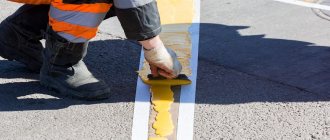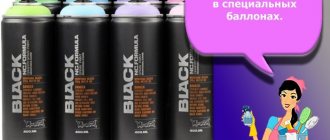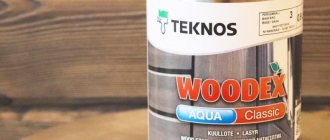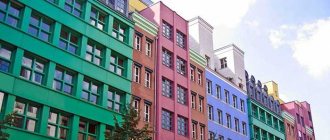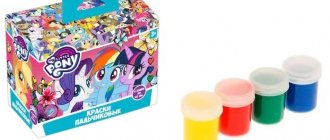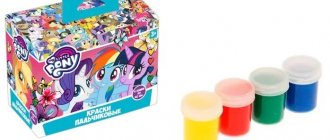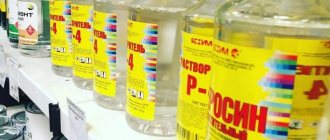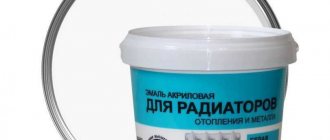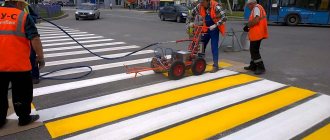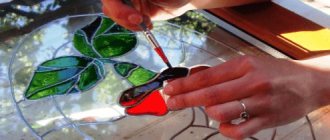Correct markings help increase highway capacity and reduce the number of accidents. The intensity of traffic affects the condition of the paint applied to the road surface.
Enamel for road markings must meet the requirements established by GOST R 51256 in the latest edition. This will extend the service life of the applied markings, reduce the cost of purchasing paint, paying workers and equipment.
The choice of paint for marking lies entirely on the shoulders of the management company, the main thing is that the composition is selected in accordance with GOST R 51256.
Road paint: composition and characteristics of the material
Marking paint contains special pigments and fillers that are diluted on an acrylic copolymer. Modifying components are also introduced into the composition.
High-quality road materials not only reflect light, but also meet a number of technical characteristics. These include the following:
- Fast drying. At a temperature of +20 degrees, high-quality materials dry within 5 minutes.
- Economical consumption of substances.
- Resistant to moisture.
- Resistance to temperature fluctuations.
- Resistance to wear and mechanical damage.
- Ease of application. Most often, a spray gun and special stencils are used for this. Thanks to the use of this technology, it is possible to apply the material quite quickly. In addition, it allows you to minimize dye costs.
When choosing a paint, it is important to consider that the substance should not cause problems with the adhesion of the car tires and the roadway.
Why do the markings glow?
Marking lines, arrows, pictograms and inscriptions must be bright and clearly visible at any time of the day or night in any weather conditions. To give the markings reflective properties, glass beads with a diameter of 100 to 600 microns (0.1-0.6 mm) are used.
Glass beads are introduced into the enamel immediately before marking is applied or distributed over the surface of the lines within 5 seconds from the moment the coloring composition is sprayed.
Glass microspheres perform several functions simultaneously:
- They reflect the light of car headlights, thereby helping drivers clearly see the markings both in fog and at night.
- Increases the wear resistance of markings and extends its service life.
- Strengthens the adhesion of wheels to the surface of the canvas.
Glass beads must be used in areas with high accident rates and on unlit sections of the road. When applying reflective markings, the consumption of glass microspheres should be at least 200-250 g per 1 square meter. m.
Varieties
Today there are quite a lot of dyes that are used for marking. They differ in shades and technical parameters.
By color
The key parameter when choosing a marking shade is its contrast with the road surface. In this case, white and yellow shades are usually used. These are the colors that are considered to be the most contrasting to the dark coating.
By gloss level
Lines are often marked with fluorescent and luminous enamels. Reflective paints are special suspensions that include phosphor-type pigments, functional components, acrylic resin solutions, and fillers. Such materials are used for marking roadways, airfields and other coatings based on cement and asphalt-bitumen compositions.
By properties
The material used for application to the road must reflect headlight light well. In this case, dyes are divided into several categories:
- Specialized paints that are often used. They are characterized by a high degree of durability. Most often, paints and thermoplastics are used to mark road marking lines.
- Paints that are used in certain situations. This group includes metal buttons, ceramic or clinker paving stones, porcelain chips, and concrete.
See also
Purpose and top 4 types of waterproof paints, pros and cons of use
The quality of markings is also influenced by the technology of using dye. The lines are applied using the cold or hot method. Individual substances can only be used in a specific method.
The cold method ensures coating durability for up to 2 years.
Expert opinion
Zakharova Irina Yurievna
Cleaning professional with 15 years of experience. Our best expert.
Ask a Question
The hot method of applying the substance is used on roads that require high speed limits. These include highways and highways.
Road marking materials
See also: Road marking standards
Road markings have become a necessary and common element of highway design.
Being an important means of organizing and streamlining the movement of traffic flows, it allows you to increase the speed of vehicles and the capacity of the road without large financial costs. High-quality road markings also help reduce the number of road traffic accidents (RTA) by more than 20%.
Important materials such as road marking paints play a very important role in supporting the process of road construction and repair.
Basic information about road markings
The type of marking applied, i.e. the location, shape and size of lines, figures and inscriptions, as well as the color of the marking are established by GOST 13508-74 “Road markings”, VSN 23-75 “Instructions for marking highways” and GOST R 51256-99 “Technical means of organizing traffic. Road markings. Types and basic parameters. General technical requirements".
The most commonly used road markings are white or yellow, but in special cases they may have a different color; there are special road paints and varnishes for this purpose.
Horizontal markings can be permanent or temporary. The functional durability of temporary markings is limited by the duration of road construction works or other events that required their introduction. (In accordance with GOST R 51256-99, temporary markings must be orange and made with materials that can be quickly removed.)
The effectiveness of the markings is determined by their good visibility at any time of the day, in any weather, regardless of the time of year, and by ensuring the necessary adhesion to the car wheel, i.e., the state of the markings throughout the entire period of operation, which, according to foreign standards, must be at least one of the year.
The condition of the marking and its durability are determined both by the properties of the material from which it is made and by the operating conditions: traffic intensity, width of the roadway, the presence of curvatures and turns on the road, the purpose of the marking lines (i.e., the position of the lines or marking patterns), and also climatic conditions.
Currently in Russia there is no scientifically based regulatory document establishing a connection between the operating conditions of the marking material and its quality. These standards are contained in the Austrian standard ONORM B 2440 “Road pavement markings. Requirements for the material and its application”, which normalizes the division of materials into four classes depending on the group of their use, associated with the purpose of marking lines and the intensity of wear.
To determine the application group, the level of influence of each of the above factors that influence marking wear is assessed by a certain number of points.
For example, the impact of average daily traffic volume is divided into three levels:
- Less than 5000 cars/day. — 1 point;
- From 5000 to 10,000 cars/day. — 2 points;
- More than 10,000 cars/day. — 3 points.
The width of the roadway is up to 6 m and the width of the traffic lane is up to 3 m - 3 points;
respectively, the same from 6 to 7.5 m and from 3 to 3.5 m - 1 point;
above 7.5 and 3.5 m - 0 points.
Edge lines - 0 points, marking of parking spaces - 2 points, marking in the sector of turns at road intersections - 3 points, on curves with a radius of up to 70 m and center lines - 4 points.
Transverse marking lines, where travel is carried out intermittently - 5 points, constantly - 10 points, etc.
By summing up the points, we get 4 groups of marking application:
- 1st group (lowest operational load) - 1-4 points;
- 2nd group - 5-8 points;
- 3rd group - 9-12 points;
- Group 4 (heaviest operational load) - more than 12 points.
Each group must correspond to a material that has optimal properties that ensure the durability of the applied markings for a certain period (i.e., belonging to a certain class). In this case, four classes are established for the marking operation periods from 12 to 48 months. These ideas deserve attention and can be used in domestic regulatory and technical documentation.
To collect statistical data on the wear of materials in order to determine their class, tests are carried out on bench equipment that simulates the operating conditions of materials on the road. An example is the ring stand of SoyuzdorNII. Based on the results obtained during bench tests, as will be shown below, the durability of road markings is calculated. It is therefore necessary that these tests be the main component of the certification tests of all road marking paints on the Russian market.
General concepts about marking materials
Various materials are used for marking: special durable paints, thermoplastics, spray plastics, thermoplastic tapes, cold plastics, and in some special cases - ceramic and clinker paving stones, porcelain chips, piece forms made of white polymer or cement concrete, colored asphalt concrete, marking blocks and plates, metal buttons and other materials. However, the largest share in the total volume of materials used for this purpose are paints and thermoplastics.
Road marking paints and varnishes differ not only in chemical composition, but also in application technology and marking service life. But it is the chemical composition that determines both the application technology and the durability of the marking. As a rule, marking material is a complex system containing from 4 to 6 or more components, including pigment, fillers, polymers, plasticizers, special additives, and solvents. Each of the components plays its own important role, but the most important of them, determining the stability, strength of the structure and, ultimately, the durability of the marking, is the binder polymer.
Modern plastics and paints for road markings are highly filled systems. According to the European standard, the standard for the indicator “dry matter residue” is a value of at least 75% for paints and at least 97% for plastics. Moreover, these standards are established in the “Environmental Requirements” section, limiting the emission of solvents and other highly volatile organic substances into the atmosphere and at the same time addressing issues of material quality.
Based on application technology, marking materials can be divided into two classes. These are materials that are used for applying road markings in a cold state at ambient temperature. These include paints and enamels based on organic solvents, water-dispersion paints, and cold plastics. Materials that are hot applied to the road surface (using melts heated to a temperature of 180-220 °C) include thermoplastics, spray plastics, and thermoplastic tapes glued to the asphalt using a gas torch. The temperature of the air and coating when applying markings with these materials should be in the range of 5-35 ° C.
Paints and enamels are used for vertical and horizontal markings. Depending on the composition and operational load, they can provide a service life of horizontal markings from one season to one year. The big advantage of paints and enamels is their convenient and safe application technology.
Cold plastics are used to apply markings in areas of greatest wear (for example, at pedestrian crossings). They provide a service life of 2 years or more.
To increase the service life of markings on roads with high traffic volumes, materials designed for applying road markings using hot technology are used.
Reflective materials
From the point of view of a person sitting behind the wheel of a car, the most important property of markings is their good visibility in bright light, and in the dark at night, and in pouring rain, and in cloudy weather, and in the light of the sun, and in the light of headlights. Thanks to this property, it is possible to reduce the number of road accidents at night by 30%.
Good visibility is achieved by using modern paints and varnishes such as reflective materials in road markings. One such material is reflective glass microbeads (GMB).
SMS are not used independently as marking material, but only in combination with it to increase the visibility of markings, especially at night, in rainy and cloudy weather. The reflective property of SMS is based on the ability of glass microbeads, which are located on the surface of the marking material, to refract the light coming from the car's headlights and reflect it at a different angle so that it hits the driver's eyes.
To achieve the greatest effect, glass microbeads must be completely transparent and (ideally) free of gas bubbles.
There are three ways to apply SMS:
- By introducing marking material inside in an amount of 10-20%;
- Sprinkling over freshly applied markings in an amount of 200-300 g/m2;
- A combination of these two methods at the same time.
In order for the headlight light, refracted by the ball and reflected from its inner surface, to reach the driver’s eyes to the greatest extent, the ball must rise halfway above the marking surface, and its surface must be free of marking material. In this case, it is also held quite well by the marking material. But if the ball protrudes more than half of the marking layer, it will easily be hit by a car wheel. And if the ball is more than half immersed in the layer of marking material, the volume of reflected light decreases.
The thickness of the dried paint layer in the markings is 150-300 microns. The size of the balls must be commensurate with this value, since for their effective and long-lasting effect the balls must lie in at least two layers. Research by SoyuzdorNII has established that the best paint for paint, both in terms of marking durability and in terms of retroreflection, are SMS with a size of 70-160 microns.
Cold plastics and thermoplastic paints and varnishes are usually applied in a layer of 2-4 mm. For them, you can use balls up to 1 mm in size. In rainy weather, when the ball is covered with a film of water, conditions are more favorable for retroreflection by large balls. When selecting the granulometry of the beads used, it is necessary to take all these factors into account.
The immersion of SMGs into the marking material is ensured by their greater density compared to the material; the necessary lighting characteristics are ensured by the refractive index of the glass used. In order to be firmly held in the marking material, the SMS must have good adhesion to it. To do this, the surface of the balls is treated with special compounds to give them hydrophobic properties.
Cold process road marking materials
Paints for road markings based on organic solvents (new developments):
Until the end of the 1990s. EP-5155 enamel was practically the only domestic enamel for road markings. It was mass-produced by three paint and varnish plants - Zagorsky, Kotovsky and Yaroslavl paint and varnish plants. The acute shortage of marking paints in various regions of Russia was covered by the use of paints and enamels for other purposes. However, most of the paint materials used were expensive imported paints. And today road workers use EP-5155 enamel to apply temporary markings. It has the necessary set of technological and lighting characteristics that make it suitable for use as a marking material.
The main disadvantages of enamel are its high (up to 60%) solvent content and the use of polymers in its formulation, which do not provide the enamel with the necessary light resistance and strength, which causes its rapid abrasion during the use of the markings.
The presence of a large number of solvents is another important disadvantage, given the high environmental safety requirements that paint and varnish materials for road markings have recently imposed on themselves.
In order to create domestic paint for road markings that is not inferior in quality to imported materials, SoyuzdorNII analyzed foreign standards (EN 1436, B 2440, TT-P-115F) for marking materials, studied publications about them, which formulated the attitude towards paint for marking roads, taking into account their operating conditions in Russia.
Research was also carried out on various domestic materials, including EP-5155, NP-501, NP-520, KO-174, NTs-132, etc., in which epoxy and petroleum polymer resins, nitrocellulose, and organosilicon compounds are used as binders and other polymers. However, none of them met the requirements.
Among the domestic paints studied, only one of them - NP-520 - had a non-volatile substance content of more than 70%. In other paints and enamels there was no more than 40% of them, i.e. they had the same disadvantages as EP-5155 enamel. And the NP-520 paint, despite the high content of non-volatile substances, had a low viscosity (20 s according to VZ-4) and turned out to be sedimentation-unstable and insufficiently wear-resistant. Therefore, SoyuzdorNII developed a new domestic paint for road markings, which is not inferior in quality to foreign paints.
Waterproof road marking paint (VMD)
The concept of the new paint, which the paint and varnish manufacturer offers today, is based on the use of domestically produced acrylic copolymers as binders with a minimum content of organic solvents.
Since the most important general indicator of the quality of road marking materials is their service life, studies were conducted on the effect of domestically produced acrylic polymers on the wear resistance of paint.
The existing method for testing the wear resistance of paint and varnish coatings according to GOST 20811-75 does not correspond to the operating conditions of the markings and does not correlate with its actual service life. Therefore, to evaluate the wear resistance of paint, a laboratory stand was built at SoyuzdorNII, which made it possible to develop a methodology that simulates the operating conditions of road markings.
Wear of paint is carried out by rubber-coated wheels of a movable wheel pair in the presence of abrasive (Lyubertsy sand of fraction 0-0.63 mm) and water under a load of 2 kgf/cm2. The paint is applied to metal plates, dried to a constant mass, mounted on a stand and tested for 1 hour. Wear on the abraded area is assessed by weighing the plates before and after testing.
The introduction of acrylic polymers reduces paint wear by 2-10 times, while the viscosity remains within the operating range of 40-80 s. In addition, the paint acquires a bright white color, and its sedimentation resistance is significantly increased.
To improve the visibility of markings at night, reflective glass microbeads (GMS) 70-160 microns in size can be introduced into the paint immediately before use (with constant stirring), and also applied to the surface of freshly applied markings.
VMD paint is applied both before the start of operation of the asphalt concrete pavement and after the opening of vehicle traffic on it. Mass production of VMD paint began in 1998.
The development of requirements for marking materials and the serial production of VMD paint gave a certain impetus to the creation and launch into production of new Russian paints for road markings based on organic solvents.
In 1999-2001 SoyuzdorNII presented paints from different regions of Russia with high technological and performance characteristics for testing. With slight differences in properties, these are materials of the same high quality level. Mass release of these materials is expected in the near future. The expansion of the materials market will contribute to the further growth of their quality and will make these materials cheaper and more accessible.
Some of the new paints took part in control field tests on the Russian, Volga and Crimea highways, organized by Rosavtodor in 2000. The quality they showed during the tests is not inferior to the level of foreign paints from Austria, Germany, France, Finland, and the Czech Republic that participated in the competition.
Water-dispersed paints for road markings
An important advantage of water-dispersion paints for road markings compared to paints based on organic solvents is environmental safety. However, low operational durability and long drying do not satisfy the requirements of road maintenance services and do not contribute to their widespread use. Improving these characteristics would put water-based paints ahead of the competition.
In recent years, water-dispersion paints and varnishes have appeared that meet the requirements of the road maintenance service for the 1st group of applications. It should be remembered: since the solvent of these paints is water, they must be stored at a temperature not lower than 0 ° C.
Cold plastic for road markings
Horizontal markings applied with paints - even those that are highly wear-resistant - do not last more than a year in the climatic conditions of Russia.
To increase wear resistance up to 2 years or more using the cold marking method, cold plastic is used. This is a two-component system in which the second component is a hardener, supplied separately. It is introduced into the composition immediately before marking is applied.
To apply markings with cold plastic, it is necessary to equip marking machines with a special unit for mixing the plastic composition with the hardener and carefully ensure that no mixture remains in it. To avoid this, they are often limited to those types of work that are done manually, for example, drawing arrows or pedestrian crossings on a stencil with a trowel, roller or drawing box - a plastic marker.
Until recently, there was no production of cold plastics in Russia. But recently, the production of cold plastic for road markings “Maksidur” (TU 5772-003-45022134-97) was organized, which is made on the basis of cold plastic “Degaroud” (Germany) using domestic and foreign components. It is a dispersion of pigments and fillers in methacrylic resin using dibenzoyl peroxide as a hardener in the form of 50% powder or paste; has high weather resistance, durability, abrasion resistance, and adhesive strength.
Main quality characteristics of "Maxidur":
- color - white, density - 1.85 g/cm3;
- whiteness - no less than 85%;
- curing time - no more than 30 minutes;
- material consumption for a coating thickness of 2-2.5 mm - 3.5-4 kg/m2;
- shelf life - at least 1 year in the manufacturer's packaging (hermetically sealed metal buckets up to 25 kg) in a dry place, protected from light at a temperature not lower than 5 ° C.
Conditions for applying markings: ambient temperature - 5-40 ° C, relative air humidity - up to 85%.
To increase the visibility of markings at night, in rainy and cloudy weather, glass microbeads are used in an amount of 200 g/m2.
Materials for hot road marking
Along with paints for road markings, thermoplastic paints and varnishes have become widespread. Their advantage over paints is that the thickness of the applied layer increases to 1.5 - 4.0 cm, and therefore the service life of the markings is extended to several years.
True, at the same time, the cost of marking work increases by 3-4 times. Therefore, thermoplastic materials are used only in places with very high wear rates, where the use of paints would be impractical, for example, on roads with a traffic volume of over 10,000 vehicles per day. in large cities and on federal highways.
The advantage of these materials over cold plastics is the completely mechanized application method. However, when working with them, it is necessary to pay great attention to the flawless operation of thermometers that control the temperature in the boilers of marking machines, since exceeding the permissible temperature leads to thermal destruction of the polymer and deterioration in the quality of the thermoplastic.
Recently, a number of new domestic enterprises have appeared in Russia producing good quality thermoplastics. There is no significant difference between domestic and foreign thermoplastics in terms of such properties of thermoplastics as “fluidity”, “spreadability”, “density”, “hardening time”, “brightness coefficient” and even “abrasion”. However, there is a significant difference in such properties as “water absorption”, “softening temperature” and “shear adhesion”.
The water absorption of foreign thermoplastics is thousandths of a percent, while that of domestic ones is tenths of a percent. The softening temperature of foreign thermoplastics is over 90 °C, domestic - 80-90 °C. Shear adhesion for foreign thermoplastics is 40-48 kg/cm2, for domestic ones - 62-88 kg/cm2.
The combination of higher values of water absorption and adhesion with a lower softening temperature probably leads to the fact that even with low abrasion ability (Table 6, column 11) the service life of domestic materials is shorter than that of foreign thermoplastics “Klinosol” (Sweden) , “Nordskilt” (Norway) and “Sinoget-Sèvres” (France), which was confirmed by control field tests of marking materials in 2000-2001.
The relationship between the indicators “gloss” and “adhesion coefficient” deserves special attention. When the gloss value is less than or equal to 14%, the adhesion coefficient is greater than 0.3, i.e. it meets regulatory requirements. With a gloss value equal to or greater than 17%, the adhesion coefficient is less than 0.3. This must be taken into account when producing thermoplastics.
Marking machines
The quality and design of road markings, as well as the correctness of its application, are ensured by marking (marking) machines.
Modern marking machines, in addition to the main technological units, must have automatic temperature control devices in the tank for heating thermoplastics, automatic control devices for the size of applied lines, and spraying of reflective fillers such as glass beads; create the necessary pressure for applying high-viscosity paints; have a set of nozzles for spraying them.
There is also a need for manual markers for working with small volumes of materials and machines for working with new types of materials. Special machines are needed to work with material such as two-component cold plastic.
In foreign research centers, marking systems are constantly being improved. New materials and technologies for their application to the road are being developed in order to increase the visibility of markings and the strength of their adhesion to the car wheel in the most difficult weather conditions. At the same time, machines are being developed for these technologies. Many foreign companies produce machines and materials in combination.
The domestic market for road repair products receives a large amount of materials from Western Europe, Asia, and the CIS countries. The companies that offer them are either well-known manufacturers of paints and varnishes, or specialized companies that produce various paints for road markings (and often equipment for their application), or enterprises that themselves carry out work on road markings, or have their own modern research centers for improving materials and technologies for road markings.
The influence of climatic conditions on the wear resistance of road surfaces
Paints and varnishes and plastics for road markings were tested at the SoyuzdorNII ring stand and on highways in different climatic conditions and at different times of the year. Tests have shown that the wear resistance of these materials sharply decreases when used in winter conditions, and a particularly strong decrease occurs when fluctuating from positive to negative temperatures and vice versa.
Wear resistance in summer is higher (for paints - 2-18 times, for plastics - 10-25 times) than in the autumn-winter period, although the test conditions (use of wet abrasive and load) were the same. Consequently, the decrease in the wear resistance of markings in winter is due mainly to low temperatures, as well as sharp transitions from positive to negative temperatures and vice versa.
Wear resistance is determined by a number of factors:
- Structural, rheological and deformative properties of the marking material;
- Deformative properties of asphalt concrete pavement;
- Interaction of the marking material with the road surface material (adhesion to the surface);
- The influence of climatic conditions, especially the influence of variable temperatures (from positive to negative and vice versa);
- The presence of freezing and thawing water in the pores of materials;
- The magnitude of the operating load.
Since the 2nd, 4th and 6th factors were the same when tested, the results obtained can apparently be explained by the influence of the 1st, 3rd and 5th factors.
The coefficients of thermal expansion and compression (deformative properties) of marking materials, as well as their wear resistance, are determined mainly by the influence of the binder polymer in the material formulation, whereas for asphalt concrete they depend mainly on the filler. Therefore, the deformative properties of these materials will always be different.
Very strong adhesion (high adhesion) between products such as road marking paints and the road surface itself under conditions of temperature fluctuations due to differences in deformation properties leads to cracks, discontinuity and destruction of markings.
Previously, it was believed that the higher the adhesion of the marking material to the road surface, the more durable the marking. Therefore, domestic manufacturers sought to increase adhesion and achieved success. However, comparative operational tests of domestic and foreign marking materials show that, for example, Klinosol and Sinozhet-Sevres, whose adhesion to asphalt concrete is 2 times less, are more durable in operation than domestic thermoplastics. Consequently, under conditions of temperature deformation, adhesion should allow materials to slide relative to each other without disturbing their continuity, and adhesive bonds should be relatively easily destroyed and re-formed in a new place. Thus, solving the problem of increasing the wear resistance of markings depends on the ability to create optimal conditions for the joint work of markings and road surfaces. This equally applies to all marking paint and varnish materials, which are offered by almost every paint and varnish manufacturer that produces them - cold plastics, tapes, etc. However, this does not eliminate the problem of improving the quality of the materials themselves, improving their structure, taking into account the fact that on a huge scale On the territory of Russia there are several climatic zones and roads with different operational loads.
The conducted research made it possible to clarify the requirements for quality indicators of thermoplastics for road markings, developed taking into account the requirements of GOST R 51256-99 and the European standard EN 1436.
What are the requirements for paints and varnishes for roads?
Marking paints can be applied manually or automatically - with a brush, roller, pneumatic or air spray. Road signs can be marked in warm weather. In this case, the temperature should be +5-35 degrees.
It is important that the substance used has the following characteristics:
- short drying period - no more than 15-30 minutes;
- economical consumption;
- high degree of hiding power;
- resistance to moisture, snow, low temperatures, acids, alkalis and other chemicals;
- high degree of wear resistance.
What is road marking and what can it look like?
Road markings are a system of lines and signs of a certain color, size and shape. It is used not only on roads, but also in parking lots, gas stations, warehouses, industrial premises and airports. Markings are applied to the roadway (this is called horizontal) or on road structures and elements of road equipment: supports of bridges and overpasses, bollards, signal posts, fences, curbs, etc. (this is called vertical).
Road markings were first used in 1911 in Detroit (USA). As an experiment, a center line was placed on the new road to separate traffic lanes. Later, similar markings appeared in the UK and then spread throughout the world.
At such an intersection, without road markings, the driver will not be able to understand
Recommendations for choosing a dye
The dyes used to apply markings differ in their chemical formula and technical parameters. It is important to choose materials taking into account the temperature in the city. To get a quality result, when purchasing a substance you should consider the following:
- climatic conditions;
- degree of traffic intensity;
- physical and chemical characteristics of the road;
- the need for color markings - black, red, yellow, orange.
Road signs are applied using one- or two-component mixtures.
Acrylic or alkyd dyes are also often used. All substances have a complex composition. They include pigments, film formers and other substances. In most cases, such enamels are produced in a standard white shade. However, other colors also exist.
Acrylic
Substances based on polyacrylates are produced in the form of a concentrated suspension. Before use, they must be mixed with water or special solvents must be used.
There are also materials that are sold in aerosol cans. They can be used without special preparation. Such substances are easy to apply and economical in consumption.
Acrylic paints are suitable for application to concrete and asphalt. They can also be used for oil-bitumen coatings. In this case, work is allowed only in dry weather, since fresh markings can be washed away.
Based on alkyd resins
Alkyd enamels include rubber components. They provide a high degree of adhesion of road markings to different types of surfaces and are characterized by excellent wear resistance. Dyes in this category are well suited for marking highways that have high traffic volumes.
See also
Top 7 types of fabric paints and how to apply them at home
It is important to note that alkyd resins cannot be applied by aerosol. This creates certain difficulties during heavy traffic.
Two-component
This type of paint is characterized by: a high degree of adhesion, excellent wear resistance, efficiency and durability. Two-component substances can be applied to different types of coatings and structures. In this case, it is permissible to use manual or automated methods.
After drying, the material forms a durable film that is resistant to the movement of dump trucks, snow removal equipment, and tractors. If you want to give the markings reflective properties, it is permissible to add quartz sand to two-component compositions. Glass beads are also used for this purpose.
What materials should be used for marking?
Today, all the requirements for paint for applying road markings are specified in GOST R 51256. Basically, white, orange or yellow paintwork is used for this purpose. The compositions used must meet the following conditions:
- be resistant to various mechanical and chemical influences;
- dry quickly;
- withstand significant temperature changes;
- be moisture resistant;
- be visible at any time of the day and under different weather conditions;
- convenient to apply;
- do not interfere with the necessary adhesion of car tires to the road surface.
GOST states that the service life of the marking should be 6 months. It is necessary that road markings are clearly visible in any lighting and retain their performance properties for as long as possible.
It is necessary to apply the composition under certain climatic conditions, namely at a road surface temperature of not lower than +15°C and a relative air humidity of not more than 85%. The most precise requirements for these indicators are prescribed by manufacturers in the instructions for paint and varnish materials. Failure to comply with these conditions may affect the wear resistance of the markings.
Marking is applied in several ways:
- manually using a roller or brush;
- spray method;
- using special marking machines.
Ideally, the material should apply well using any of these methods. You can buy AK-511 road paint or other products for road marking from our company. We offer a wide range of polymer and paint and varnish materials for marking.
What types of paints are used today for road markings?
Features of applying the compositions, their characteristics and additives.
Correctly executed markings are one of the components of road safety. Signs and lines placed on asphalt in accordance with traffic regulations increase the capacity of avenues, streets and highways, and also reduce the likelihood of accidents by 25%. However, these data are valid for high-quality work, and this largely depends on the choice of paint for marking. What compounds and additives do road workers use today?
Rating of popular brands
The most popular substances that are often used for road markings include the following:
- TechnoNIKOL AK. This product is a one-component substance that must be applied cold. It is based on high-quality pigments and fillers. The dye does not require the use of solvents - it is ready for use. The composition is suitable for drawing horizontal lines on the road. It can be used for asphalt or concrete pavement.
- Indecoat-511. This material is used quite often. Essentially, it is a combination of pigments, additives and fillers. The composition can be used in a wide temperature range, which ranges from -40 to +60 degrees. The material is characterized by high wear resistance and whiteness. It can be applied to concrete and cement surfaces.
- Enamel AS-5307 “Line”. This dye is often used to apply safety lines. It can be used for concrete and asphalt pavement. Contains reflective beads. With their help, it is possible to achieve the glow of the markings. Brightness settings reach 80%.
Glowing road lines
Markings that have glowing properties are not found everywhere, but they are mandatory for highways and roads with heavy traffic.
Such markings reflect car headlights and are needed to prevent road accidents. In addition, the person driving can navigate in the dark, and the reflective paint will help him see the signs painted on the asphalt.
Features of using specific paint
Before using special paint, preliminary markings are required. It can be applied manually or using devices that are present in marking machines. The work area must be fenced off from vehicles.
Then you need to identify key points that will become the basis for marking. To do this, it is recommended to use a curvimeter. You can draw dots with chalk. Then they should be pre-marked.
At the next stage, it is recommended to prepare the road surface. To do this, it needs to be cleaned of dust and dirt. Usually they use a watering machine. A machine equipped with brushes and blowers will also work. After cleaning, the road should dry completely.
If there is old markup, you must first remove it. This can be done mechanically or hydraulically. It is also permissible to paint the lines in the color of the road surface. However, this method is used only when removing markings for a short period of time.
Expert opinion
Zakharova Irina Yurievna
Cleaning professional with 15 years of experience. Our best expert.
Ask a Question
When applying road signs, it is recommended to paint the center lines first. Other elements must be placed in parallel. Therefore, they should be applied with a marking machine, which is equipped with a telescopic bracket.
To properly apply paint, it is recommended to use equipment that is appropriate for the material being used. Markings must be applied pneumatically or hydraulically. This means that air can be used for the procedure. To carry out the work, it is recommended to do the following:
- prepare material;
- check the equipment;
- fence off the work area;
- apply markings;
- provide protection to the road surface until the material is completely dry;
- remove barriers.
See also
Types of paints for stoves and application rules, top 8 best manufacturers
Preparation of the material involves mixing paints when using multi-component compositions and mixing until smooth when using dyes with one ingredient.
After pouring the substance into the tank of the car, it must be placed on the part of the road that you plan to test paint. If the test is successful, the machine must move in the direction of traffic and carry out painting procedures. Using the on-board computer, you can adjust the length of the strokes.
In most cases, special equipment is used to apply road markings. However, sometimes it is acceptable to use hand tools. They are most often used for painting small or complex areas.
For this purpose, brushes, rollers and stencils are used. Sometimes it is necessary to use spray guns. In most cases, they are present in marking machine kits.
The main tool for manual marking is a template. It helps control the size of the lines. In most cases, aluminum or steel sheets with a thickness of 1.5 millimeters are used as a template.
Acrylic based coatings
These are concentrated water-soluble paints, characterized by convenience and ease of use. The compositions are applied by any means: manually or using special equipment. But most often aerosol spraying is used. Acrylic paints are suitable for application to oil-bitumen, concrete or asphalt surfaces. The compositions are characterized by their relatively low cost and ease of use: before use, they just need to be diluted with water. Some manufacturers offer these products in aerosol packages. The downside of acrylic paint is that it needs to be applied only in dry weather (complete drying time is half an hour).
Precautionary Methods
When using dyes, it is important to take precautions:
- The dye must not be opened or applied near fire sources or flammable liquids.
- All work must be performed using protective equipment. To do this, you need to wear a special suit, glasses, gloves, and a respirator.
- If paint gets on your skin, rinse it immediately with water.
- Do not use water, kerosene or gasoline to thin paints or wash tools.
Application Features
Paints and enamel for road markings are applied to a previously cleaned and dry surface using marking machines. The mechanized method of spraying paint materials is usually used when creating horizontal marking lines. Various signs, letters and numbers are painted by hand through stencils using brushes, rollers or a special spray paint gun.
Road marking using paints and varnishes must be carried out in the warm season at a temperature not lower than +5 °C. If necessary, marking work can be carried out at a lower temperature, but in this case the drying time of the paint will increase. If marking is carried out at a temperature of about +20 ° C, the road with freshly applied marking lines will be ready for use in just 5-15 minutes after painting is completed.
